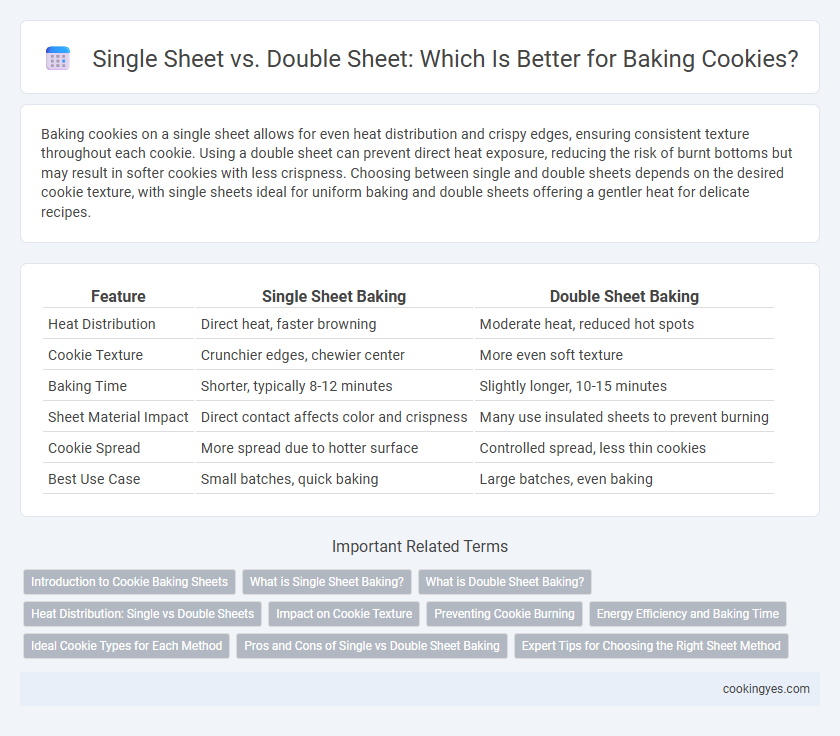Baking cookies on a single sheet allows for even heat distribution and crispy edges, ensuring consistent texture throughout each cookie. Using a double sheet can prevent direct heat exposure, reducing the risk of burnt bottoms but may result in softer cookies with less crispness. Choosing between single and double sheets depends on the desired cookie texture, with single sheets ideal for uniform baking and double sheets offering a gentler heat for delicate recipes.
Table of Comparison
| Feature | Single Sheet Baking | Double Sheet Baking |
|---|---|---|
| Heat Distribution | Direct heat, faster browning | Moderate heat, reduced hot spots |
| Cookie Texture | Crunchier edges, chewier center | More even soft texture |
| Baking Time | Shorter, typically 8-12 minutes | Slightly longer, 10-15 minutes |
| Sheet Material Impact | Direct contact affects color and crispness | Many use insulated sheets to prevent burning |
| Cookie Spread | More spread due to hotter surface | Controlled spread, less thin cookies |
| Best Use Case | Small batches, quick baking | Large batches, even baking |
Introduction to Cookie Baking Sheets
Single sheet cookie baking pans provide even heat distribution ideal for uniform baking and crisp edges, while double sheet pans offer enhanced insulation preventing over-browning and promoting softer centers. Material composition, such as aluminized steel or heavy-gauge aluminum, greatly influences baking performance by affecting heat conductivity and pan durability. Choosing between single and double sheet pans depends on the desired cookie texture and baking consistency for optimal results.
What is Single Sheet Baking?
Single sheet baking involves placing cookies on a single baking sheet to ensure even heat distribution and uniform baking. It helps prevent overcrowding, allowing cookies to spread properly and achieve consistent texture and browning. This method is preferred for maintaining optimal airflow and avoiding unevenly baked cookies caused by stacking or using multiple sheets simultaneously.
What is Double Sheet Baking?
Double sheet baking involves placing cookies on a baking sheet lined with a second, empty baking sheet underneath to create insulation. This method prevents the cookie bottoms from browning too quickly and promotes even heat distribution, resulting in evenly baked cookies with a softer texture. Compared to single sheet baking, double sheet baking reduces the risk of burnt bottoms and helps maintain consistent baking temperatures.
Heat Distribution: Single vs Double Sheets
Single sheet cookie baking ensures more even heat distribution, allowing cookies to bake uniformly with consistent texture and color. Double sheet baking can create uneven heat transfer, often causing the bottom sheet to bake slower or the top sheet to receive excessive heat, leading to inconsistent results. Optimizing heat distribution is crucial for achieving perfect cookies with balanced moisture and crispness.
Impact on Cookie Texture
Single sheet cookie baking produces a crispier texture with even browning, as heat is directly concentrated on one layer of dough. Double sheet baking can retain moisture, resulting in a softer, chewier cookie due to the insulation effect between the two layers. Bakers seeking a balance between crunch and chew often adjust baking times and temperatures to optimize texture based on sheet configuration.
Preventing Cookie Burning
Using a double sheet for cookie baking provides better heat insulation, reducing direct contact with the oven rack and significantly lowering the risk of cookie burning. A single sheet allows more intense heat transfer, which can cause the bottom of cookies to brown too quickly or burn. Bakers seeking evenly baked cookies often prefer double sheets for consistent heat distribution and improved prevention of burnt edges.
Energy Efficiency and Baking Time
Single sheet baking for cookies uses less energy as it requires heating only one tray at a time, reducing overall oven workload and promoting faster, more even heat penetration. Double sheet baking, while capable of producing larger batches, often prolongs baking time due to uneven heat distribution between sheets, which can lead to inconsistent cookie texture and increased energy consumption. Optimizing baking with a single sheet maximizes energy efficiency and shortens baking duration, resulting in cost-effective and uniform cookie batches.
Ideal Cookie Types for Each Method
Single sheet baking works best for chewy or soft cookies like chocolate chip or oatmeal, as it allows gentle heat distribution, promoting even baking without excessive crispiness. Double sheet baking suits crispier, thinner cookies such as biscotti or sugar cookies, as the extra layer insulates the dough from direct heat, reducing browning and preventing burning. Choosing the appropriate method depends on the desired texture and cookie thickness to optimize baking results.
Pros and Cons of Single vs Double Sheet Baking
Single sheet baking offers even heat distribution and crispier edges, making it ideal for small batches and delicate cookies, but it can limit capacity and slow down large-batch production. Double sheet baking increases oven space utilization and can prevent bottom burning by providing insulation between sheets, though it may result in less consistent heat, causing uneven baking or softer textures. Choosing between single and double sheets depends on desired texture, batch size, and oven performance for optimal cookie results.
Expert Tips for Choosing the Right Sheet Method
Single sheet baking promotes even heat distribution and consistent browning, ideal for delicate cookies requiring uniform texture; double sheet baking helps prevent bottom burning by adding insulation, perfect for thicker or high-sugar doughs prone to over-baking. Experts recommend using heavy-gauge aluminum sheets for single-sheet baking to optimize thermal conductivity and switching to double sheets with a parchment liner when working with recipes that tend to spread excessively or caramelize quickly. Selecting the right baking sheet method enhances cookie quality, texture, and overall appearance by providing precise control over heat exposure and bake time.
Single sheet vs double sheet for cookie baking Infographic

 cookingyes.com
cookingyes.com